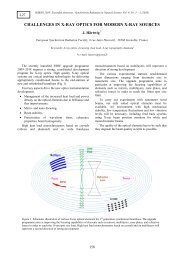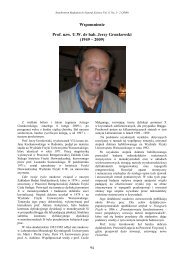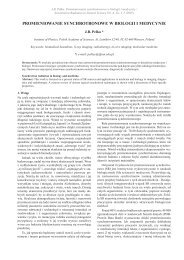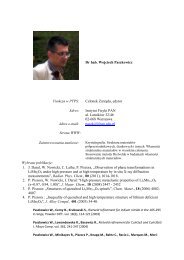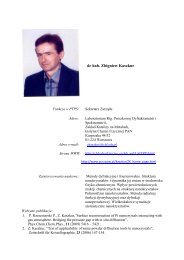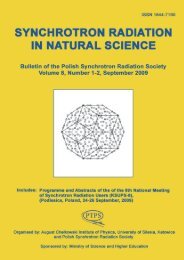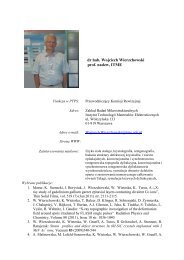studies of structrural changes induced by uv and vuv laser pulses
studies of structrural changes induced by uv and vuv laser pulses
studies of structrural changes induced by uv and vuv laser pulses
- No tags were found...
Create successful ePaper yourself
Turn your PDF publications into a flip-book with our unique Google optimized e-Paper software.
P44ISSRNS 2010: Extended abstracts / Synchrotron Radiation in Natural Science Vol. 9, No. 1 – 2 (2010)STUDIES OF STRUCTRURAL CHANGES INDUCEDBY UV AND VUV LASER PULSESD. Klinger 1 , R. Sobierajski 1,8 , M. Jurek 1 , J. Krzywinski 1,5 , J.B. Pelka 1 , D. Żymierska 1* ,R. Minikayev 1 , B. Kozankiewicz 1 , J. Chalupský 2,3 , L. Juha 2 , V. Hájková 2 , J. Cihelka 2 ,T. Burian 2,3 , L. Vyšín 2,3 , H. Wabnitz 4 , W. Caliebe 4 , K. Tiedtke 4 , S. Toleikis 4 ,T. Tschentscher 4 , R. London 5 , S. Hau-Riege 5 , K. Sokolowski-Tinten 6 , N. Stojanovic 6 ,J. Hajdu 7 , A.R. Khors<strong>and</strong> 8 , A.J. Gleeson 9 , <strong>and</strong> K. Nowakowska-Langier 101Institute <strong>of</strong> Physics, Polish Academy <strong>of</strong> Sciences, Al. Lotników 32/46, PL-02-668 Warsaw, Pol<strong>and</strong>2Institute <strong>of</strong> Physics, Czech Academy <strong>of</strong> Sciences, Na Slovance 2, 182 21 Prague 8, Czech Republic3Czech Technical University in Prague, Brehova 7, 115 19 Praha 1, Czech Republic4Deutsches Elektronen-Synchrotron DESY, Notkestrasse 85, D-22603 Hamburg, Germany5Lawrence Livermore National Laboratory, 7000 East Avenue, CA 94550 Livermore, USA6University <strong>of</strong> Duisburg-Essen, D-45117 Essen, Germany7Uppsala University, SE-75124 Uppsala, Sweden8FOM-Institute for Plasma Physics Rijnhuizen, P.O. Box 1207, 3430 BE Nieuwegein, The Netherl<strong>and</strong>s9CCRLC Daresbury Laboratory, Warrington, Cheshire, WA4 4AD, UK10Andrzej Soltan Institute for Nuclear Studies, PL-05-400 Świerk/Otwock, Pol<strong>and</strong>Keywords: <strong>laser</strong> processing, XUV free electron <strong>laser</strong>, material modification, <strong>laser</strong> ablation, synchrotron radiation, X-ray diffraction*) e-mail:zymier@ifpan.edu.plInvestigations <strong>of</strong> the interaction <strong>of</strong> <strong>laser</strong> radiationwith optical materials have remained strenuous in the lastdecade. Especially, the interaction <strong>of</strong> ultra short <strong>laser</strong>pulse with matter has been studied. In the research theinfluence <strong>of</strong> the pulse duration [1, 2] <strong>and</strong> the material[3-5] on the ablation threshold were taking into accountbut many questions referred to ablation remain open asbefore. In order to reveal differences in results <strong>of</strong>interaction <strong>of</strong> short (ns) <strong>and</strong> ultra short (fs) <strong>laser</strong> <strong>pulses</strong>with matter, we carried previously out experimental<strong>studies</strong> <strong>by</strong> means <strong>of</strong> the interference–polarizingmicroscopy using the Nomarski reflection contrast,atomic force microscopy, <strong>and</strong> theoretical simulation <strong>of</strong>the process. The interaction with matter <strong>of</strong> ns <strong>laser</strong> <strong>pulses</strong>consists in thermal processes. The energy <strong>of</strong> <strong>laser</strong>radiation is transferred into the lattice in the form <strong>of</strong> athermal energy in a nanosecond time scale causingmelting <strong>of</strong> the surface layer. Next recrystallisation occurswhich is continued after the <strong>laser</strong> pulse. We investigatedthese effects in single silicon crystals as well as inimplanted samples. In dependence on <strong>laser</strong> annealingconditions (the energy density <strong>and</strong> duration) polycrystallisation,structural reordering or creation <strong>of</strong> microcrystalliteson amorphous layer occurs [6,7]. Interaction<strong>of</strong> fs <strong>laser</strong> pulse with matter differs from that <strong>of</strong> ns pulse.XUV radiation permits a high degree <strong>of</strong> electronicexcitation. The temperature <strong>of</strong> the electronic systemgrows up rapidly (in a femtosecond time scale, < 100 fs).Further, at a picosecond time scale the electron gas coolsdown <strong>by</strong> the heat transfer to the crystal lattice. If thelattice temperature reaches the phase transition point, thedamage occurs. The depth <strong>of</strong> the damaged volumeincreases due to the thermal diffusion in the lattice thathappens on a nanosecond time scale. We studied theirradiation damage in silicon single crystals [8,9].The aim <strong>of</strong> the present work is an X-raycharacterisation <strong>of</strong> materials in which structuralmodifications were <strong>induced</strong> with nanosecond <strong>pulses</strong>generated <strong>by</strong> excimer <strong>laser</strong> <strong>and</strong> the intense XUVfemtosecond <strong>pulses</strong> generated <strong>by</strong> the TESLA test facilityfree electron <strong>laser</strong> (TTF FEL) at DESY, Hamburg. Theresults was obtained <strong>by</strong> X-ray diffraction method usingsynchrotron radiation at the W1.1 beam line at DESY-Hasylab. The monochromatic X-ray beam <strong>of</strong> thewavelength λ = 1.54056 Ǻ was applied. Themeasurements were recorded with 2θ scans in theglancing incidence geometry <strong>and</strong> with ω-2θ scans. Thismethod permitted us to determine the quality <strong>of</strong> crystalstructure <strong>of</strong> samples. The samples were investigatedbefore <strong>and</strong> after irradiation with <strong>laser</strong> radiation, this waythe <strong>changes</strong> in crystallographic structure causing <strong>by</strong> theablation were revealed, namely the creation <strong>of</strong> microcrystalliteson the amorphous or polycrystalline surfaces<strong>of</strong> studied samples was observed.Acknowledgements: This work was supported in part <strong>by</strong> theMinistry <strong>of</strong> Science <strong>and</strong> Higher Education (Pol<strong>and</strong>) underspecial research project No. DESY/68/2007.References[1] M. Lenzner, "Femtosecond <strong>laser</strong>-<strong>induced</strong> damage <strong>of</strong>dielectrics," Int. J. Mod. Phys. B 13 (1999) 1559–1578.142
ISSRNS 2010: Extended abstracts / Synchrotron Radiation in Natural Science Vol. 9, No. 1 – 2 (2010)[2] A. Rosenfeld, M. Lorenz, D. Ashkenasi, P. Rudolph, J.Krueger, W. Kautek, "Femtosecond- <strong>and</strong> nanosecondpulse<strong>laser</strong> ablation <strong>of</strong> bariumalumoborosilicate glass," Appl.Phys. A 69 (1999) 759–761.[3] T.Q. Jia, Z.Z. Xu, R.X. Li, D.H. Feng, X.X. Li, C.F. Cheng,H.Y. Sun, N.S. Xu, H.Z. Wang, "Formation <strong>of</strong> nanogratingson the surface <strong>of</strong> a ZnSe crystal irradiated <strong>by</strong> femtosecond<strong>laser</strong> <strong>pulses</strong>," Phys. Rev. B 72 (2005) 1254291–1254294.[4] I.H. Chowdhury, A.Q. Wu, X. Xu, A.M. Weiner, "Ultrafast<strong>laser</strong> absorption <strong>and</strong> ablation dynamics in wide-b<strong>and</strong>gapdielectrics," Appl. Phys. A 81 (2005) 1627–1632.[5] K. Sokolowski-Tinten, J. Bialkowski, A. Cavalleri, D. vonder Linde, A. Oparin, J. Mejer-ter-Vehn, S.I. Anisimov,"Transient states <strong>of</strong> matter during short pulse <strong>laser</strong>ablation," Phys. Rev. Lett. 81 (1998) 224–227.[6] D. Klinger, J. Auleytner, D. Żymierska, B. Kozankiewicz,L. Nowicki, A. Stonert, "Pulsed <strong>laser</strong> annealing <strong>of</strong> SnimplantedSi single crystal", J. Appl. Phys. 95 (2004) 2331–2336.[7] D. Klinger, E. Łusakowska, D. Żymierska, "Nano-structureformed <strong>by</strong> nanosecond <strong>laser</strong> annealing on amorphous Sisurface", Mat. Sci. Semi. Mat. 9 (2006) 323–326.[8] J.B. Pełka, R. Sobierajski, D. Klinger, W. Paszkowicz, J.Krzywiński, M. Jurek, D. Żymierska, A. Wawro, A.Petroutchik, L. Juha, V. Hajkova, J. Cihelka, J. Chalupsky,T. Burian, L. Vysin, S. Toleikis, K. Sokolowski-Tinten, N.Stojanovic, U. Zastrau, R. London, S. Hau-Riege, C.Riekel, R. Davies, M. Burghammer, E. Dynowska, W.Szuszkiewicz, W. Caliebe, R. Nietu<strong>by</strong>ć, "Damage in solidsirradiated <strong>by</strong> a single shot <strong>of</strong> XUV free-electron <strong>laser</strong>:Irreversible <strong>changes</strong> investigated using X-raymicrodiffraction, atomic force microscopy <strong>and</strong> Nomarskioptical microscopy", Rad. Phys. Chem. 78 (2009) S46–S52.[9] R. Sobierajski, D. Klinger, M. Jurek, J.B. Pelka, L. Juha, J.Chalupský, J. Cihelka, V. Hajkova, L. Vysin, U. Jastrow,N. Stojanovic, S. Toleikis, H. Wabnitz, J. Krzywinski, S.Hau-Riege, R. London, "Interaction <strong>of</strong> intense ultrashortXUV <strong>pulses</strong> with silicon", Proc. SPIE 7361 (2009) 736107-1–11.143



